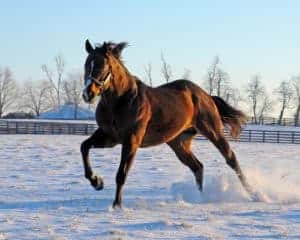Standing Colic Surgery? In Some Cases It’s Possible
- Topics: Article
What do you do when two colic surgeries have failed, and the equine patient is still in a great deal of pain? One team of veterinarians facing this scenario tried something a little different on one 7-year-old Swiss Warmblood gelding and, as it turned out, the third surgery—a standing, hand-assisted procedure—was the charm.
“We couldn’t see the lesion that was causing the colic—in this case, a mesenteric defect—when we used traditional laparoscopic (camera-assisted) techniques,” said Thomas Witte, BVetMed, PhD, FHEA, MRCVS, Dipl. ACVS, ECVS, RCVS-Recognized Specialist in Equine Surgery. “But when we adopted a hand-assisted technique, which allows manipulation of the intestine directly with one hand, we were able to identify and correct the lesion. Being able to see and visually inspect the defect was critical to the success of the repair, especially because we were able to locate and avoid all the regional blood vessels.”
Witte, a senior lecturer in equine surgery at the Royal Veterinary College in Hatfield, England, said veterinarians discovered the gelding had a tear in his mesojejunum, a layered tissue in the abdomen that helps hold the jejunum (the middle part of the small intestine) in place. Part of the horse’s small intestine had slipped through the tear (also called a rent) and become stuck, causing it to swell and tighten. In their first surgery, they could only see the swelling and displacement of the intestines, and so they corrected that. But eight hours later, the horse experienced severe colic again. The team operated again and saw the tear, but couldn’t reach it to fix it correctly, Witte said.
“We tried to fix the rent at the second surgery under general anesthesia and couldn't get to the most proximal (closest to the horse's back) part of it,” he said. “The risk of only partially closing the rent is that it is then smaller, and so there is an even greater chance of the bowel becoming strangulated than there is with a big rent. So we left it in the hope that it would perhaps remain clinically insignificant
Create a free account with TheHorse.com to view this content.
TheHorse.com is home to thousands of free articles about horse health care. In order to access some of our exclusive free content, you must be signed into TheHorse.com.
Start your free account today!
Already have an account?
and continue reading.

Related Articles
Stay on top of the most recent Horse Health news with

















